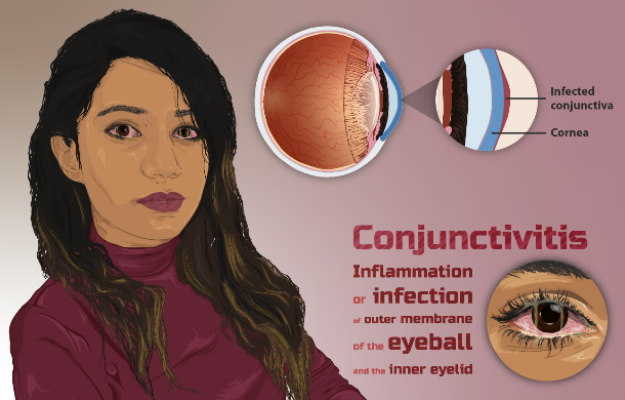What is Conjunctivitis?
Conjunctivitis is the inflammation of the conjunctiva, which is a thin membrane that lines the white part of the eyes and inside of the eyelids. Conjunctivitis is a condition that is commonly seen in children and spreads to others, if infectious.
What are its main signs and symptoms?
Symptoms seen in conjunctivitis are:
- Pinkish or reddish discolouration in the white part of the affected eye.
- Increased tearing.
- Burning and itching in the eyes.
- Excessive discharge of the mucus.
- Swelling of the eyelids and conjunctiva.
- Irritation in the eyes.
- A sensation of a foreign body in the eye.
- Disturbances in vision.
- Sensitivity to light.
- Sticky substance on the eyelashes in the morning on waking up.
What are the main causes?
The most common causes of conjunctivitis are infections, allergy and irritants in the environment.
- Infection is commonly caused by bacteria, such as staphylococcus, chlamydia and gonococcus, and viruses. The infection is spread by insects, physical contact with infected people and contaminated eye cosmetics.
- Allergy commonly occurs due to exposure to pollen, dust mites, animal hair/feathers, use of hard or soft contact lenses for a long time without replacing.
- Common environmental irritants are pollution (smoke, fumes, etc.), chlorine in pools and toxic chemicals.
How is it diagnosed and treated?
Based on the history, signs and symptoms, and examination of the eye, your doctor (ophthalmologist) will be able to diagnose conjunctivitis. An eye examination includes checking if the vision has been affected and evaluating the conjunctiva, external eye tissue and inner structures of the eye. Usually, this eye condition lasts for less than four weeks. In the case of prolonged infection or poor response to treatment, a swab (where a sample of mucus/discharge is collected) is taken and sent for examination.
Treatment of conjunctivitis depends upon the cause. Antibiotic drops are given for bacterial infections, but not for viral infections. Viral infections usually run their course. Cool compresses and artificial tears are used for symptomatic relief. For allergic conjunctivitis, antihistamines and eye drops are given. Use of contact lenses during conjunctivitis should be avoided.
You can protect other members of your family from getting infected by:
- Not touching your affected eye/s.
- Proper washing of hands.
- Avoiding sharing of towels and cosmetics.

 Doctors for Conjunctivitis
Doctors for Conjunctivitis  OTC Medicines for Conjunctivitis
OTC Medicines for Conjunctivitis
 Conjunctivitis articles
Conjunctivitis articles

 Homeopathic Treatment of Conjunctivitis
Homeopathic Treatment of Conjunctivitis







 Dr. Rachita Narsaria
Dr. Rachita Narsaria











